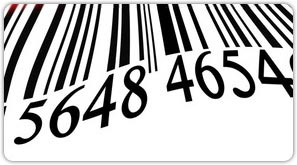Linear barcode

Codabar is a linear barcode symbology developed in 1972. It is also known as Codeabar, Ames Code, NW-7, Monarch, Code 2 of 7, Rationalized Codabar, ANSI/AIM BC3-1995 or USD-4. Codabar was developed for use in a variety of non-retail applications such as libraries, shipping, and the medical industry.
➜EAN stands for European Article Number (EAN-8) code and used for small packages where an EAN-13 barcode would be too large. An EAN-8 number contains 7 digits of message plus 1 check digit. The first two or three digits identify the numbering authority; the remaining 4 or 5 digits identify the product.
➜It is also known as Code 3 of 9 or the 3 of 9 Code1.It is commonly used for various bar coding labels, such as name badges, inventory and industrial applications. The code is easy to use and is designed for character self-checking. The asterisk character is used as the start and stop character and therefore should not be included in the sequence to be encoded.
➜Code 128 includes 107 symbols: 103 data symbols, 3 start codes, and 1 stop code. To represent all 128 ASCII values, there are three code sets (A, B, C), which can be mixed within a single barcode (by using codes 98 and 99 in code sets A and B, 100 in code sets A and C and 101 in code sets B and C to switch between them).
➜Data bar Code 128 Set A is one of the most popular modern 2D barcode font standards. It is a very high density barcode font that supports capital letters, numeric values, control codes and punctuation. Data bar Code 128 Set A is widely implemented in many applications including for inventory and tracking purpose.
➜Code set B is used for alphanumeric data that has both lower case letters and uppercase letters in it. Code 128 set B symbology can be used for most of the characters within the standard lower 128 ASCII table. This barcodes symbology can handle most input data. The Code 128 set B start bar has its own check digit calculation value assigned to it.
➜Code 128 barcode symbology is used for alphanumeric or numeric barcodes. Data bar Code-128 barcode contains a checksum digit for verification purpose. To represent full 128 ASCII value code 128 utilizes three characters set A, B and C.
➜Interleaved 2 of 5 barcode is same as industrial 2 of 5 symbology, the only difference is that Interleaved 2 of 5 encodes information in both the bars and spaces while Industrial 2 of 5 encodes information in the bars only.
➜Code 39, the first alpha-numeric symbology to be developed is still widely used in non-retail industry. It is the standard bar code used by the United States Department of Defense, and is also used by the Health Industry Bar Code Council (HIBCC).
➜Code 11 is a barcode symbology developed by Intermec in 1977. Code 11 is used primarily in telecommunications. The symbol can encode any length string consisting of the digits 0-9 and the dash character (-). One or more modulo-11 check digit(s) can be included.
➜Telepen is most widely used linear barcode symbology that expresses all 128 ASCII characters without using shift characters for code switching. Unlike most of the linear barcodes that specify the encodings for each representable character, Telepen only defines four basic bar-space modules.
➜USS-93 is one of the most popular linear barcode symbology that designed in 1982 by Intermec. USS-93 is high density barcode symbology and provides data security enhancement to Code 39. USS-93 is primarily used in Canadian postal office to encode supplementary delivery information.
➜MSI Plessey is numeric and variable length linear barcode symbology that developed by the Plessey Company of England. It is mainly used in retail business. Each character consists of eight elements, four bars and four spaces.
➜USPS tray label is one of the most widely used linear barcode symbology that is used in United States Postal Services (USPS) for labeling of postal trays, automation rate mailings, periodicals /standard mail (letter size and flat size pieces) etc.
➜





